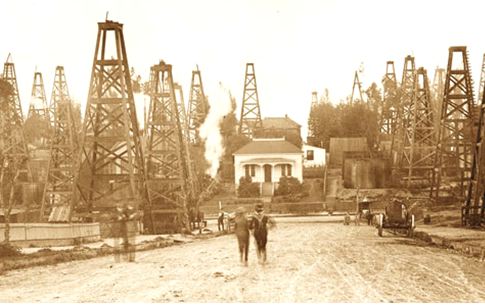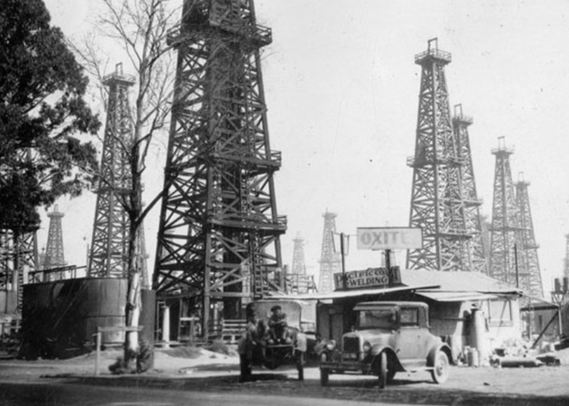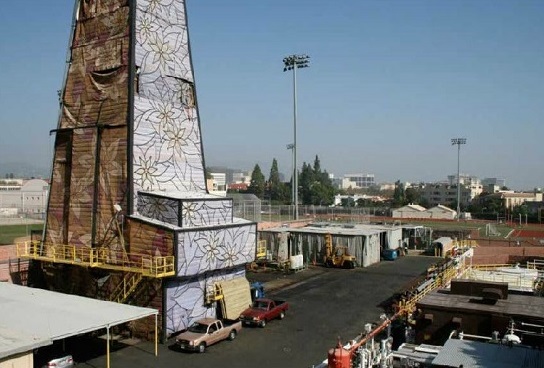Natural oil seeps, giant oilfields, and the beginning of the California petroleum industry.
“Everyone thinks of Los Angeles as the ultimate car city, but the city’s relationship with petroleum products is far more significant than just consumption.” — Center for Land Use Interpretation
When struggling prospector Edward L. Doheny and his mining partner Charles Canfield decided to dig a well in 1892, they chose a site already known for its “tar” pools that bubbled to the surface.

Edward Doheny discovered the Los Angeles oilfield in 1892 when he drilled into tar seeps near present-day Dodger Stadium. Photo courtesy the Center for Land Use Interpretation, Culver City, California.
Doheny reportedly was downtown when he noticed a cart with a black substance on its wheels. The Los Angeles oilfield’s history would begin when Doheny asked the driver where he had come from.
On April 20, 1892, Doheny and his partner Canfield struck oil near present-day Dodger Stadium and revealed the giant Los Angeles City field, part of the onshore and offshore geology of California oil seeps.

The Los Angeles City oilfield at the turn of the century. Photo courtesy California History Room, California State Library, Sacramento.
The “tar” Doheny had seen on the cart’s wheels was asphalt from one of California’s animal-trapping pools discovered in 1769 by a Spanish explorer (the seeping bitumen misnamed as La Brea).
The Los Angeles City oilfield discovery well, completed in 1893 between Beverly Boulevard and Colton Avenue, set off California’s first oil boom by producing about 45 barrels a day. Within a few years, hundreds of L.A. oil wells were pumping oil to be refined into wagon axle greases — and kerosene for lamps.
Los Angeles Oil Boom
Doheny and Canfield became millionaires by drilling wells — using steam boilers and cable-tool technology — and selling the oil production to the city’s quickly expanding industries.

The 1892 discovery of the giant Los Angeles oilfield began a long relationship with petroleum that helped create “the ultimate car city.” Photo courtesy Library of Congress.
Doheny also found success in Mexico, where his company in 1916 made the world’s largest oil discovery at the time. Charged with bribery in the 1920s during Wyoming’s Teapot Dome scandal, he was acquitted in 1930. Doheny later became known for his financial support of foundations and California universities.
Excitement surrounding the Los Angeles oilfields would also lead to the oil career of Emma A. Summers, a graduate from the New England Conservatory of Music, who moved to Los Angeles in 1893.

A 1901 publication featured Emma Summers and her “genius for affairs” that put her in control of the Los Angeles City oilfield and earned her title.
Caught up in the “oil fever” of the new petroleum industry, the former piano teacher would become known as California’s “Oil Queen.” A 1901 newspaper article noted, “If Mrs. Emma A. Summers were less than a genius she could not, as she does today, control the Los Angeles oil markets.”
Learn more about the remarkable Mrs. Summers in Oil Queen of California.

A tower moves on tracks, servicing 19 wells drilled at sharp angles under the adjacent neighborhood. Photo courtesy the Center for Land Use Interpretation.
By 2014, more than nine billion barrels of oil had been produced in the Los Angeles area — with more than 30,000 active wells pumping around 230 million barrels of oil a year. Los Angeles County earned its place as the second most productive oil county in California, second only to the giant oilfields in Kern County.
“The history of Los Angeles is intertwined with the use and production of gasoline and oil,” noted an article from the Center for Land Use Interpretation, Culver City, California. “Everyone thinks of Los Angeles as the ultimate car city, but the city’s relationship with petroleum products is far more significant than just consumption.”
Downtown L.A. well sites have highlighted educational field trips organized by the Center for Land Use Interpretation. The petroleum production sites were in a 2014 Atlantic magazine article with many revealing images, The Urban Oil Fields of Los Angeles.
In addition, the city of Long Beach has creatively hidden offshore production platforms (see THUMS – California’s Hidden Oil Islands).
The search for California oil went offshore in 1896 when petroleum companies built piers to reach where oilfields extended into the Pacific Ocean — thus launching the U.S. offshore industry.
North of Los Angeles in Santa Barbara County, the prolific Summerland oilfield — also found near asphalt seeps — enticed Henry Williams and his associates to build a pier 300 feet out into the Pacific and mount a standard cable-tool rig on it.
Hollywood Gusher
The 2007 Academy Award-winning movie “There Will Be Blood” was loosely based on Oil!, the 1927 novel by Upton Sinclair. The main character was even more loosely based on Edward Doheny.

Edward L. Doheny, discoverer of the Los Angeles oilfield, was loosely portrayed in a 2007 Oscar-winning movie. Poster image courtesy Miramax Films.
“Although the script is based on the Upton Sinclair novel, Paul Thomas Anderson (writer-director) used only the first hundred and fifty pages for a big portion of the material,” noted a film critic. “The rest was contrived. The novel’s setting was in 1920s but it was moved to the beginning of the oil boom in California.”
Oil and gas museums provided advice, photographs, cable-tool rig blueprints and other materials that benefited filming. According to the director, the fake oil used for gushers was “the stuff they put in chocolate milkshakes at McDonald’s.”
Technical help came from the Kern County Museum in Bakersfield, the West Kern Oil Museum in Taft, and the Petroleum Museum in Midland, Texas, among others. Learn more California petroleum history in Signal Hill brings California Oil Boom.
South of Los Angeles, in Orange County, the Brea Museum and Historical Society tells the story of the Olinda Oil Well No. 1 well of 1898 — yet another important California petroleum discovery. Visit the city of Brea’s Olinda Oil Museum and Trail in Brea.
_______________________
Recommended Reading: Oil! (1926); Dark Side of Fortune: Triumph and Scandal in the Life of Oil Tycoon Edward L. Doheny (2001); The Great Los Angeles Swindle: Oil, Stocks, and Scandal During the Roaring Twenties (1996);. Your Amazon purchase benefits the American Oil & Gas Historical Society. As an Amazon Associate, AOGHS earns a commission from qualifying purchases.
_______________________
The American Oil & Gas Historical Society (AOGHS) preserves U.S. petroleum history. Please become an AOGHS annual supporter and help maintain this energy education website and expand historical research. For more information, contact bawells@aoghs.org. © 2025 Bruce A. Wells.
Citation Information – Article Title: “Discovering Los Angeles Oilfields” Authors: B.A. Wells and K.L. Wells. Website Name: American Oil & Gas Historical Society. URL: https://aoghs.org/petroleum-pioneers/los-angeles-oil-field. Last Updated: April 12, 2025. Original Published Date: April 1, 2014.



